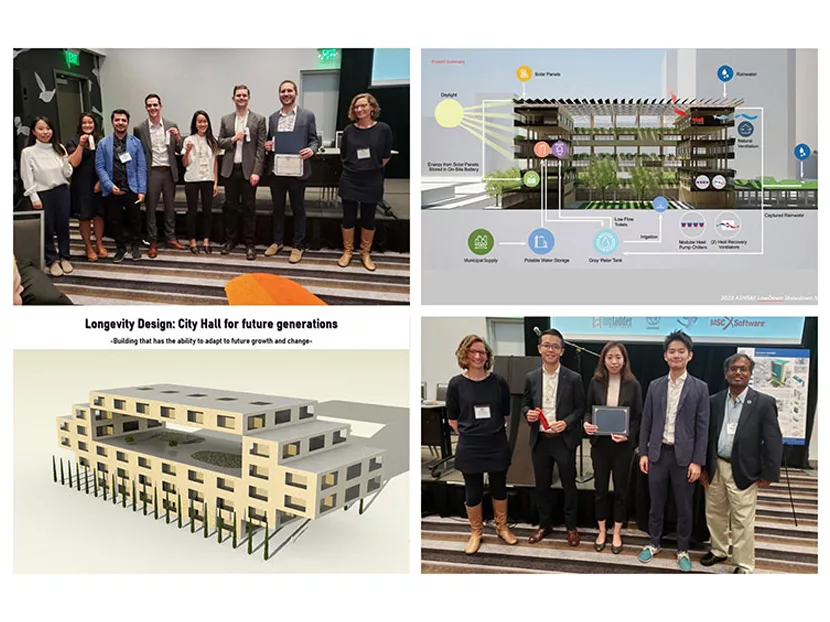ASHRAE has recognized the 2019 LowDown Showdown modeling competition teams. The competition was held in conjunction with the 2019 ASHRAE Building Performance Analysis Conference, Sept. 27-29 in Denver.
The ASHRAE LowDown Showdown engages architects, engineers, designers and energy modelers by working on integrated teams in the creation of effective workflow and outstanding design in real-word building efficiency challenges.
“The competition not only challenged teams to achieve near net-zero, but also to include design and modeling elements to create a resilient building capable of withstanding natural disasters and providing prolonged emergency operations,” said Annie Marston, competition chair.
This year’s model building was a 90,000-square-foot city hall (new construction) located in San Diego. The project involved designing a facility that is meant to be a multi-functional building, housing many of the cities vital public services including being an Emergency Operations Center in times of disaster or crisis.
Teams were evaluated in six categories:
- Energy use
- Teamwork
- Innovative approach
- Creativity
- Workflow
- Presentation
First place and fan favorite were awarded to C.R.E.A.M. (Carbon Rules Everything Around Me) for a proposed city hall that can maintain operations for 14 days during a utility outage to coordinate emergency responses while maintaining critical functions like prisoner life safety and security. During an event, the building will transition to a setback mode, minimizing energy consumption by relaxing thermal comfort targets. Building systems will then draw energy from a 10,000 kWh battery system and 427 KW PV array for power and 10 kgal potable and 20 kgal non-potable water storage tanks.
“We saw the Lowdown Showdown as an opportunity for our team to collaborate across Built Ecology offices coast to coast and to experiment using new tools and workflows,” said Jason Lackie, team captain for C.R.E.A.M. “With the wide-ranging scope of this year’s competition - encompassing aspects of energy, water, resiliency, and health and wellness - everyone had a chance to step up and showcase their expertise while also being challenged to integrate that work with an evolving design. As much as the pallet of tools we drew on helped with this multifaceted design problem, our team’s success depended on our ability to collaborate through obstacles.”
Other teams presenting their results are as follows:
Highway to Sustainability – This second place team designed a new city hall with a three-story atrium to provide ample space for green walls, skylight and natural breeze. The project included a spacious semi-outdoor area for fitness activities and the deployment of EnergyBox, an in-house web platform which speeds up design exploration by automating processes and encouraging collaboration by effective visualization.
Operation ReSHED – The team’s project included elevated walkways to surrounding critical government buildings for quick access to the Emergency Operations Center residing inside the new city hall. The vertically massed city hall was would be designed not only to transform the skyline, but creates opportunities for resiliency against forecasted disasters, increasing energy efficiency during the regular operation and to provide a safe and healthy environment for the occupants.
Parametric Posse – The team incorporated parametric modeling to replace design assumptions made with data-driven simulations to achieve a holistic design that exceeds technical requirements, leverages passive strategies, and supports use during emergency situations. Using both proprietary and open-source software for the parametric modeling, the base digital model allowed for interface with energy, daylighting, and climate analysis tools.
Ulti-Performance - The team’s project included assembling an integrated team using a variety of design tools to achieve a net positive building designed for comfort, using dynamic glazing, natural ventilation, and a green roof outdoor amenity. Resilience features included underground water cistern, PV and battery storage.
The results were announced at a reception during the conference. Complete project overviews, including team posters, are available on the 2019 ASHRAE LowDown Showdown Modeling Challenge results webpage.
The sixth annual LowDown Showdown Competition will take place at the 2020 Building Performance Analysis Conference and SimBuild co-organized by ASHRAE and IBPSA-USA in Chicago.





